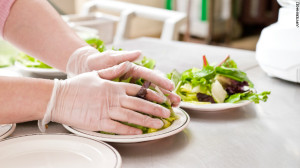Public discussions over a no bare hand contact rule (or glove rule as some folks refer to it) continues to get heated in California. As the industry and regulators trade barbs in the media, the focus moves into chef’s rights and away from public health.
Focusing on just no bare hand contact (or not) misses the bigger picture. Outbreaks happen because of lots of factors. Bare hand contact is one of them. That’s what I told Betty Hallock of the Los Angeles Times:
“[Making safe food is] not about gloves or not gloves,” says Ben Chapman, an assistant professor at North Carolina University and contributor to Barfblog.com, which covers food safety issues. “It’s are you doing the right things when you’re touching food, whether you have gloves on or not.”
But chefs aren’t convinced. Many think the ban will bring about more detrimental habits. And added costs.
“The Band-Aid of a blanket glove regulation is potentially dangerous,” says Neal Fraser, chef-owner of the Beverly Boulevard restaurant BLD. “People get into the tendency to not wash their hands.”
Dyanne Weiss of the Liberty Voice expands on Fraser’s thoughts in parallel coverage.
Several concerns, however, have been raised about the efficacy of banning direct use of hands by restaurant workers and make the use of gloves questionable as a solution. The first is a health concern raised by a hand hygiene study conducted by the CDC’s Environmental Health Services. The researchers collected data on hand washing and hygiene behavior in 321 randomly chosen restaurants in several states, including California. They found that workers washed their hands well for 27 percent of the food preparation activities where washing is recommended. When gloves were used, hand washing was even less likely to occur.
This echoed findings from a 2005 study where more than a third of restaurant workers acknowledged that they did not always change their gloves in between handling raw meat or poultry and ready-to-eat food. Getting hands dirty handling meat made workers want to wash their hands, but the gloves gave a false sense of sanitation. Another issue raised by the glove requirements is the plastic waste created if all restaurant workers switched out single-use gloves for each item prepared. Oregon dropped its restaurant worker glove requirement last year for environmental reasons.
Yep, there’s data that says food handlers do dumb things with gloves, can lead to less handwashing and might have a false sense of safety. Missing from the discussion is a more recent look at inspection violations in restaurants linked to outbreaks compared to those that haven’t been traced to illnesses. Petran and colleagues published the results in a 2012 Journal of Food Protection article and have data that shows a bare hand contact violation is twice as likely to occur at a norovirus outbreak-linked restaurants than what the authors call a nonoutbreak restaurant. Other food handler factors that seem to matter for norovirus outbreaks: single use and single service articles (relative risk of 8.82 when comparing outbreak to nonoutbreak restaurants) proper eating/tobacco use by staff (of 5.88) and cross-contamination (2.21).
Hallock writes that the rule has hit the sushi community particularly hard.
For decades, Toshiaki Toyoshima has followed the same ritual each morning at his downtown restaurant: He ties on his indigo happi — a short-sleeved Japanese chef’s jacket — and dons a white cap before he begins cutting fish for nearly 500 customers who dine at Sushi Gen daily.
But in January, Toyoshima’s tradition-bound routine was upset. He had to add a step: A new law now forces him to snap on a pair of thin vinyl gloves before he can touch the fish.
But the normally stoic Toyoshima can’t hide his frustration. Having to wear gloves, he says, is the worst thing that has happened to him in 48 years as a sushi chef.
“I don’t feel connected to my food,” says Toyoshima, known to diners as “Toyo-san.” “It’s like I’m not making sushi with my own hand.”
“The whole idea of making sushi is to touch it, feel it,” Toyoshima says. “It comes from within, and then through my hands.”
I don’t want to eat anywhere where something from within ends up in my food via someone’s gloved or ungloved hands.
